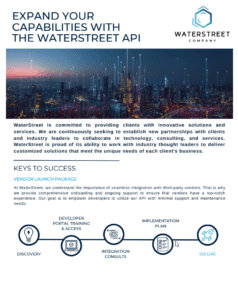Many insurers are seeking better ways to employ data for assessing risk.
The Internet of Things (IoT) has made this possible by creating a network of connections between software and devices. For the P&C insurance industry, this means using new methods of segmenting risk based on home and auto behavioral data.
WaterStreet Company offers cloud-based P&C insurance solutions for easily adopting next-generation risk assessment techniques.
Risk Segmentation Enhanced Across Industries
IoT connected devices have made an impact across industries as the cost for sensors has drastically gone down in the past decade.
Harvard Business Review has highlighted the heightened competition this brings to companies able to adapt to smart products. As consumers become aware of the value behind their data, companies will become challenged to enhance the benefits offered in order to retain loyalty. HBR points out, “knowing how customers actually use the products enhances a company’s ability to segment customers, customize products, set prices to better capture value, and extend value-added services.”
Segmenting customers with new IoT data is spreading across industries, and especially useful in P&C insurance underwriting for new home and auto policies.
Auto Insurance & IoT Data
Most modern drivers have adapted to using smartphones, giving auto insurers an easy method of gaining insight into the behavior of drivers. As drivers carry smartphone with them while driving, this data is easily collected based on GPS.
Many automakers are also taking data collection to the next level. Modern vehicles are beginning to be manufactured with sensors in the vehicle. Insurance companies can partner with these automakers to allow data sharing with the driver’s consent.
Here are examples of how drivers can be segmented based on their behavior:
- Drivers who travel long distances vs short distances
- Drivers who drive during busy times of the day vs drivers who drive when there is less traffic
- Drivers who break hard when coming to a stop vs drivers who do not break hard
Auto insurers can enroll policyholders in new risk pools, segmenting drivers based on their behavior and offering rewards as a result. This is referred to as Usage-based Insurance (UBI) for setting rates based on how drivers use their vehicles.
Home Insurance & IoT Data
Smart homes are gradually becoming more reality than fiction. Some home advancements are not so useful for insurers, but other advancements can actually serve to communicate relevant data to the insurer and can even save homeowners on home insurance premiums.
Segmenting risk for homeowners with smart technology depends on the sensors implemented in the home. Here are examples of sensors gaining popularity:
- Smart lock sensors for locking automatically when left unlocked
- Window and door sensors for determining if a window or door has been left open
- Flood sensors for sensing when waters are rising in or around the home
Insurers can choose to offer discounted rates for segments of policyholders who choose to update their home with smart, data-sharing technology.
Home insurers can also take advantage of solutions such as self-inspection applications. The homeowner can send information directly to the insurer’s system for providing evidence of home improvements and for submitting claims.
WaterStreet Company & IoT Data
WaterStreet Company offers cloud-based P&C insurance software, allowing insurers to bring more data into their system.
Thanks to our advanced API, we’re able to connect insurers to any number of third-party data solutions.
Reach out to WaterStreet Company today to request a consultation and demo of our solutions.





